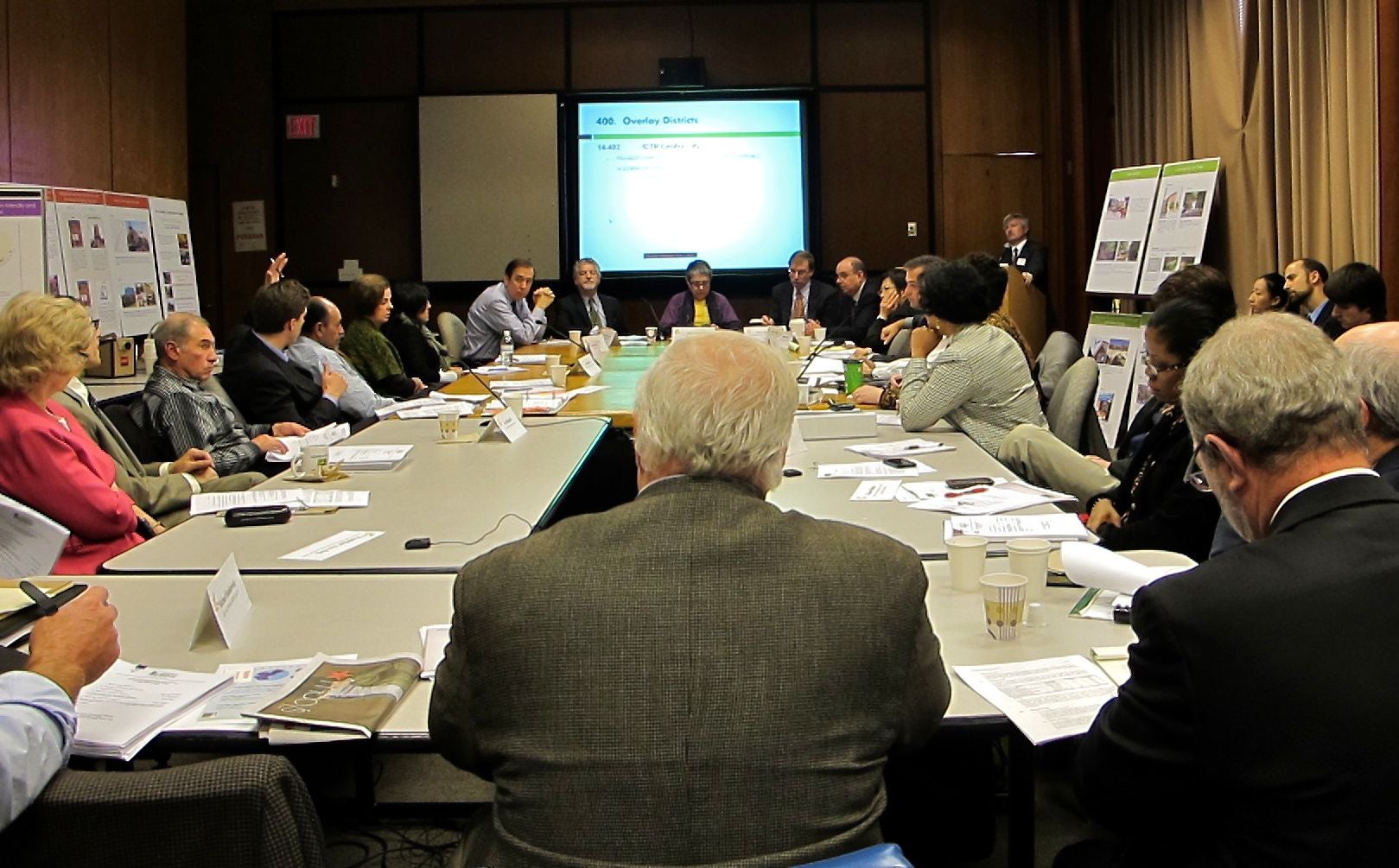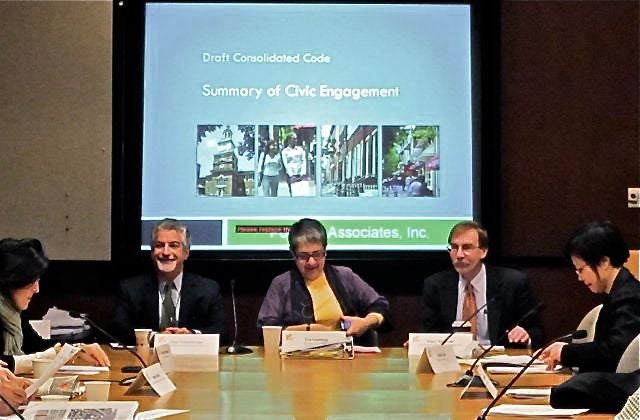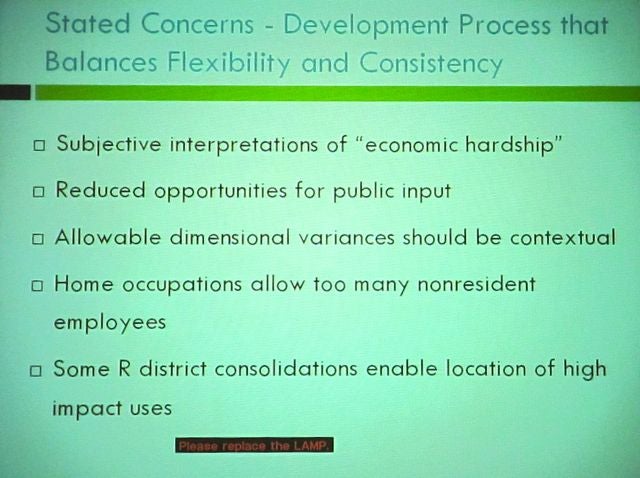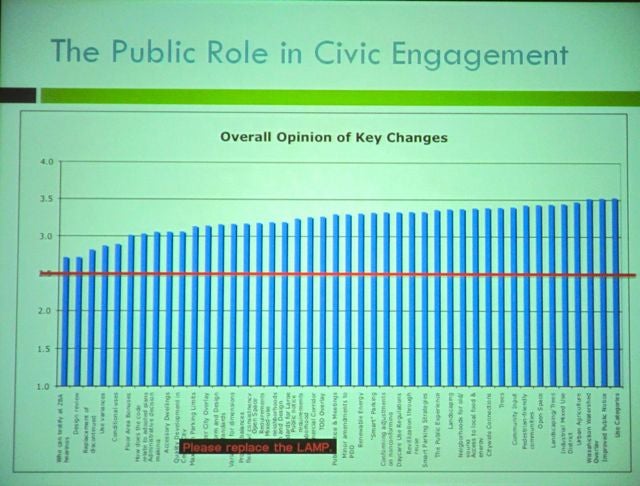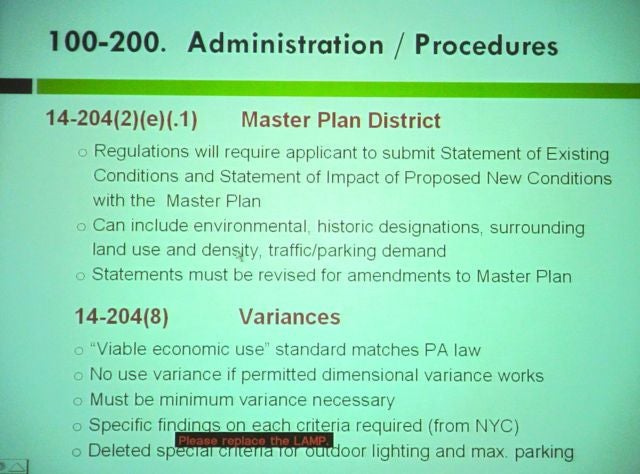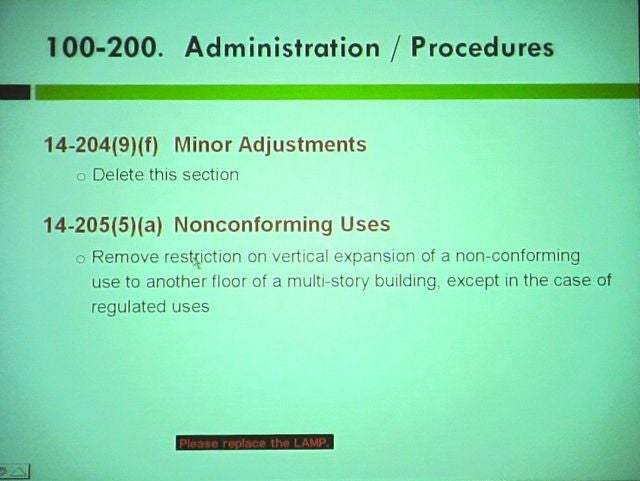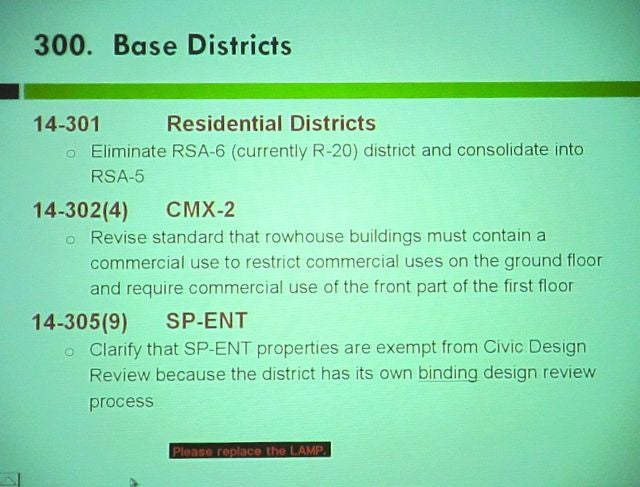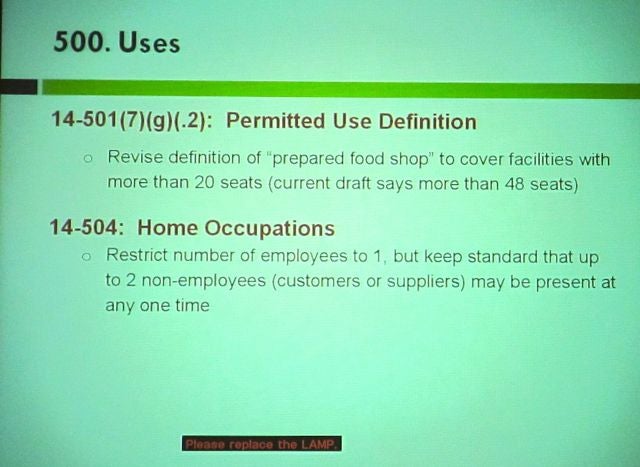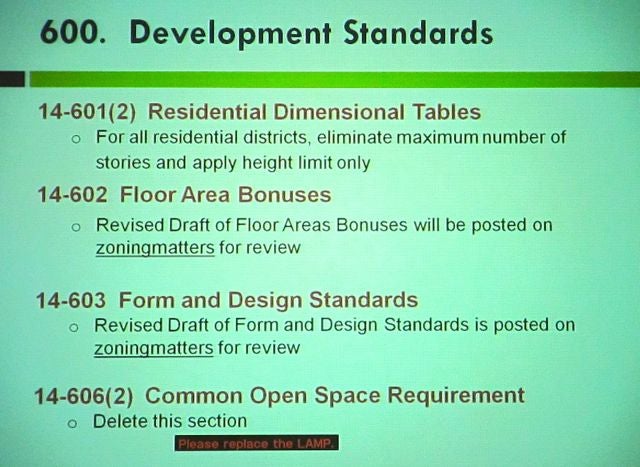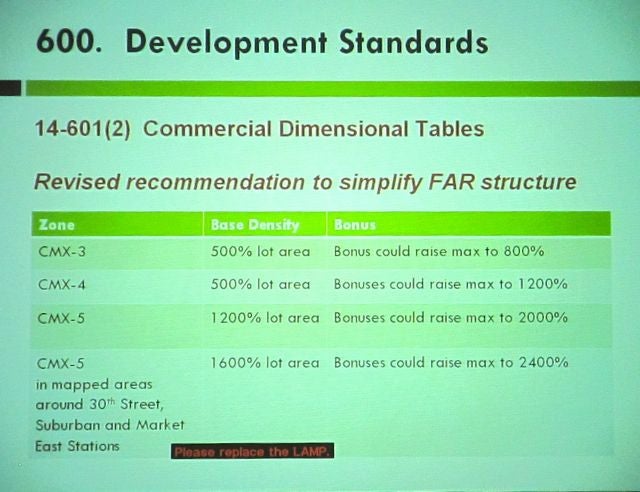ZCC reports successful civic engagement, but ADUs, Uses, Deadlines still at issue
The open period for written comment on Philadelphia’s zoning code revisions closes on Friday, November 12. On Wednesday, the Zoning Code Commission presented ongoing work about floor areas of buildings and floor area bonuses, and presented an overview of how public feedback has fed into the development of the code revision. Commissioners and the public also discussed a variety of ongoing concerns, including accessory development units, how to understand changes to permitted uses in the new zoning districts, and whether enough time is permitted to digest ongoing revisions to the draft code.
Philadelphia City Planning Commissioner Alan Greenberger opened the meeting by praising the Citizens Planning Institute—an educational effort by the commission to help Philadelphians understand and participate in the planning process—and focused on changes to the size of permitted buildings in his remarks. The revisions to what’s allowed in commercial mixed-use areas of Center City have been tweaked again, part of a continuing evaluation and assessment of appropriately-scaled development for Center City. Instead of permitting buildings near Center City transit hubs to have an unlimited floor area ratio (also known as FAR, which is the gross floor space that may be built based on multiple of a building’s lot size), that base ratio will now be capped at 16 times the lot size.
“This is in lieu of unlimited FAR in the same areas,” Greenberger said. “This was an attempt to do two things. One, to expand capacity for density in these particular areas, which we think has value, and at the same time not create the kind of force we see at work in a lot of the city where land use values—where increased zoning has caused a lot of people to believe their properties are worth more than the market is willing to pay for it, and doubly bad, there are people who are willing occasionally to pay for these properties. And then they get stuck, with no development, because the going in costs were too high.”
Greenberger also said that rather than using a blunt instrument like a radius from those Center City transit hubs to determine where larger buildings may be constructed, such parcels will be specifically mapped. He also said that such a draft map had made its way into the world, but was not a product of the Zoning Commission.
“I don’t think the map will be unobvious to everybody,” Greenberger said, “but the map is not yet posted. We understand that there’s a draft map in C-5 areas. I’m told that it’s not bad, but we didn’t draft it.”
(Aside: did you draft this mystery map? Or do you have a copy? Like Greenberger, we’d like to see it. Send it our way: ngilewicz@planphilly.com.)
ZCC executive director Eva Gladstein announced that the draft Zoning Administrative Manual and the Regulations of the Zoning Code have both been posted to zoningmatters.org, in addition to an updated Center City overlay.
Commissioner Stella Tsai, head of the Civic Engagement Committee, said that with Tuesday’s final open house at Independence Visitor Center, the committee has completed this portion of the civic engagement process. She introduced Owen Franklin from Portfolio Associates, who presented a substantive report on the civic engagement process.
According to Franklin, public participation was large. Over 3,500 “instances of participation”—such as completing surveys at the recent open houses—have occurred over the past three years in response to the ZCC’s initial requests for feedback about public priorities and values, and later, to the code itself. That number, Franklin said, does not include the various stakeholder and ZCC meetings that took place.
Additionally, public feedback highlighted occasional communication problems because of how some development issues were framed.
“One interpretation that people have come to throughout this process is that TOD (Transit-oriented Development) standards would be applied across Center City and that Center City would be one TOD node. This is not the case,” Franklin said.
Franklin also offered Civic Design Review as one process that benefited from public input. Initially, it was one of the lowest-rated changes, a 2.7 on a scale of 1 to 4. Comments from the public indicated concern with how the process would be triggered, and a desire for a representative from the proposed project’s area to sit on the review committee. After changing the size triggers and adding the rotating neighborhood seat to the CDR Committee, the public rated the latest version of CDR 3.4 on that same scale.
Following consultant Don Elliott’s presentation detailing floor area bonuses in greater detail and other specific changes to the code, the question-and-answer session was polite, but pointed and often contentious. Councilman Brian J. O’Neill reiterated his objections to a blanket creation of a new housing class—accessory dwelling units (ADUs)—across the city, and his desire to see a chart detailing how use regulations from old zoning districts map onto new ones to more easily see specific changes.
“I don’t want to see us rushing through this,” O’Neill said, “and we’ve got all these uses allowed now that weren’t allowed before, and people have worked hard over the years to make sure they weren’t allowed in different areas.”
“We’ll take a snapshot in terms of what’s on the charts today. We’ll show what all the lists of existing uses are for each category—residential, commercial, and industrial, and show what categories they roll up to in the new code. And then you have to compare which of the individual uses were permitted in the old code,” Gladstein replied, promising that the ZCC would provide that snapshot before the next meeting.
Elliott told O’Neill that the administration of ADUs was still being actively discussed, and ZCC commissioner Andy Toy underscored that interest in them does exist in the city.
“Maybe there’s a need to carve it out or something,” Toy said, “but there is a big group of people out there that are in favor of ADUs, especially the aging* community. I think Eva was just at a conference yesterday about that. There is a ground swell of support for that somewhere.”
“If there’s a lot of support for this,” O’Neill replied, “I’m not going to have a personal opinion on that. I’m going to want to support that need. It is the citywide overlay all of a sudden. We’re supposed to being doing good work, here, we’re not supposed to be doing harm. For many neighborhoods, that would be harm.”
“I don’t want to add any overlay districts at this point,” Elliott said, reiterating his oft-stated objections to overlays. He argued that detailing use restrictions based on zoning districts would be a better way to address the matter. “I think it’s a given that the ADU applicability needs to be tailored, narrowed, and refined into certain areas.”
Greenberger recognized the challenge of working through these bumps in the zoning road, but reasserted his commitment to keeping the code revision on schedule.
“There’s no way we’re letting this code go down on a handful, or a couple of issues. If in the end we have to come up with a slightly complex issue that would accommodate things that would otherwise be killer issues, we’re gonna figure out how to do it. We’ll recommend to you that we suck it up and live with the complexity,” Greenberger said.
But this Friday’s deadline was of concern to both Craig Schelter of Development Workshop and to Sam Little of the Logon Square Neighborhood Association. Schelter argued that given the ongoing changes, especially to sky plane regulations, not enough time exists for developers and architects outside the ZCC process to understand the impact of the regulations and give sufficient comments.
The shifting regulations, according to Schelter, are the reasons that Development Workshop has not submitted more extensive comments. Little said this is one of the few times he though his and Schelter’s interests aligned, insofar as sky plane regulations are likely to have direct effects on the Logan Square neighborhood and residents, like developers, want to understand those effects.
Greenberger indicated that, where ongoing work is occurring, he might be open to further feedback. But he emphasized that Friday’s deadline is, generally speaking, a hard deadline for written feedback, and that as the process moves forward to City Council, the public will again have the opportunity to state their concerns during Council hearings.
As for the edits and changes thus far, an updated draft of the zoning code, marked up to show substantive revisions to date and footnoted to show sections that have been reorganized, will be available on December 1 according to Elliott.
*An earlier version of this story incorrectly suggested that Toy referred to the Asian, rather than the aging, community. PlanPhilly regrets the error.
Contact the reporter at ngilewicz@planphilly.com
WHYY is your source for fact-based, in-depth journalism and information. As a nonprofit organization, we rely on financial support from readers like you. Please give today.



